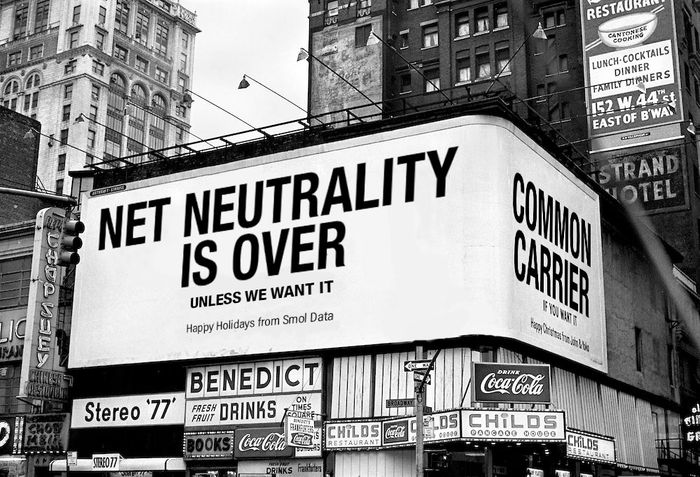
I was happy to provide comments for an article by Eileen Guo about Net Neutrality and mesh networking. It was was helpful in formulating my thoughts on the FCC’s recent decision to rescind Net Neutrality rules (see also: my last email newsletter).
I’m including the emailed questions for the article and my responses here in full.
Eileen: There has been a lot of interest in net neutrality in the past, does this time feel any different?
Me: Compared to the 2010 battle over SOPA/PIPA, this year’s FCC vote has felt like there’s way more at stake. The political landscape has shifted so dramatically this year. I’m still trying to figure out if Net Neutrality advocates are all spread thin protesting other issues, or if 2017 is when resistance became normalized along with Trump normalizing creeping authoritarianism. Dismantling what paltry telecom oversight was in place feels like just another front on the Trump administration’s war on journalism and civic discourse. The response coming from state government and congress has me cautiously optimistic, but this last year has conditioned me to expect that the fight will only demand more organizing and collective action.
Eileen: Is mesh internet technology in the U.S. now at the point where mesh can be an alternative to ISPs?
Me: What’s interesting to me about mesh technology is that you can build out the infrastructure without digging up a trench. However, it occupies a place in the public imagination that may not always sync up with the boring reality. A lot of what people think about when they hear “mesh” are community mesh projects like Catalonia’s GUIFI or NYC Mesh. The two parts aren’t tightly coupled: the mesh technology and the peer-to-peer community possibilities can be understood separately. For example, the ISP I have in Troy, NY, MassiveMesh, uses mesh networking technology, but aside from the antenna on my roof it provides a service that is entirely equivalent to Comcast or Spectrum. On the other hand, my wifi darknet project occupy.here relies on the community dynamics you find in community mesh, but does not actually use mesh technology.
Listening to Ajit Pai’s statement during the FCC vote had me nodding in agreement when he listed big Internet tech companies that aren’t scrutinized, but it was a bad faith attempt at whataboutism, and belies his disinterest in actually regulating the industry he came from himself as a former Verizon attorney. Yes, we should be concerned about tech monopolies, as Nathan Schneider argued well in his Quartz piece. But we should understand why smaller firms, like my local ISP, are less likely to treat me poorly compared to the bigger players who monopolize broadband markets. Sometimes regulation is designed to protect the bigger players from local upstarts, like my mesh ISP. We need to be arguing in terms of human rights and not technical minutiae that are boring and difficult to understand.
So, while I’m pleased to have a good mesh ISP option where I live, I am still going to fight hard for those who don’t have that privilege.
Eileen: I wanted to clarify: you can connect to your community ISP (and would that be the correct term?) completely separately from mesh, but you ALSO connect to a mesh Internet network, right? Do you share wifi from your ISP on mesh with others that don’t have it? And is this allowed by your ISP’s user agreement?
Me: I honestly haven’t read the fine print for MassiveMesh, but now I am curious if they allow customer peering beyond their own infrastructure. Basically they use rooftop mesh connections to create a point-to-point network from their office outward to each customer. Each time they stand up an antenna it means they can reach new customers who have line of sight to that structure. I don’t think of it as “community mesh” (even though it is local) because I can’t connect to the other customers directly. At least, I can’t connect to the other customers on the application layer of the network, we are connected on the lower-level physical layer. One thing that is different is that they agreed to give me a public static IPv4 address for a reasonable $5/month extra charge. Basically it’s a locally-run, non-monopolizing ISP that also happens to use mesh technology to minimize infrastructure costs.
I am a big fan of community mesh projects like NYC Mesh, which I think of as being defined by volunteerism and mutual aid. But for my ISP, that I depend on for my work, I am happy with the arrangement to pay MassiveMesh so I don’t need to be the one to debug problems when they arise.
One other related project: Dhruv Mehrotra’s Othernet.